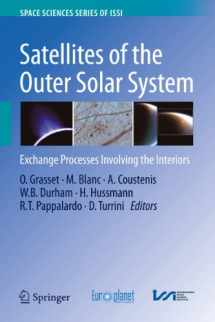
Satellites of the Outer Solar System: Exchange Processes Involving the Interiors (Space Sciences Series of ISSI, 35)
ISBN-13:
9781441974389
ISBN-10:
1441974385
Edition:
2010
Author:
M. Blanc, William Durham, O. Grasset, A. Coustenis, H. Hussmann, R. Pappalardo, D. Turrini
Publication date:
2010
Publisher:
Springer
Format:
Hardcover
540 pages
Category:
Astronomy
,
Astronomy & Space Science
,
Astrophysics
,
Physics
,
Solar System
,
Geology
,
Earth Sciences
FREE US shipping
Book details
ISBN-13:
9781441974389
ISBN-10:
1441974385
Edition:
2010
Author:
M. Blanc, William Durham, O. Grasset, A. Coustenis, H. Hussmann, R. Pappalardo, D. Turrini
Publication date:
2010
Publisher:
Springer
Format:
Hardcover
540 pages
Category:
Astronomy
,
Astronomy & Space Science
,
Astrophysics
,
Physics
,
Solar System
,
Geology
,
Earth Sciences
Summary
Satellites of the Outer Solar System: Exchange Processes Involving the Interiors (Space Sciences Series of ISSI, 35) (ISBN-13: 9781441974389 and ISBN-10: 1441974385), written by authors
M. Blanc, William Durham, O. Grasset, A. Coustenis, H. Hussmann, R. Pappalardo, D. Turrini, was published by Springer in 2010.
With an overall rating of 4.4 stars, it's a notable title among other
Astronomy
(Astronomy & Space Science, Astrophysics, Physics, Solar System, Geology, Earth Sciences) books. You can easily purchase or rent Satellites of the Outer Solar System: Exchange Processes Involving the Interiors (Space Sciences Series of ISSI, 35) (Hardcover) from BooksRun,
along with many other new and used
Astronomy
books
and textbooks.
And, if you're looking to sell your copy, our current buyback offer is $0.3.
Description
Recent space missions to the outer solar system, Galileo (1996–2003) and Cassini-Huygens (2004–today), together with ground observations, have revealed that the moons of the outer solar system are enigmatic objects, introducing extraordinary challenges for geologists, astrobiologists, organic chemists, and planetologists. Chemical exchange exists through the different layers that form their interiors, and also from the interior to the surface. The most convincing evidence is certainly the discovery of water vapour and ice particles emerging from Enceladus’s active south polar region. Evidence for exchange with a subsurface liquid ocean has also been provided by the inference of hydrated salts on the surfaces of Jupiter’s moons, Europa and Ganymede, as well as the detection of sodium salts in particles originating in Enceladus’s plumes. Aqueous exchange with the rocky core may also be possible, considering that 40Ar has been observed in the plumes of Enceladus during one flyby of Cassini and in the atmosphere of Titan. The ongoing CH4 replenishment in Titan’s atmosphere is additional striking evidence of exchange processes within the moons.


We would LOVE it if you could help us and other readers by reviewing the book
Book review

Congratulations! We have received your book review.
{user}
{createdAt}
by {truncated_author}


